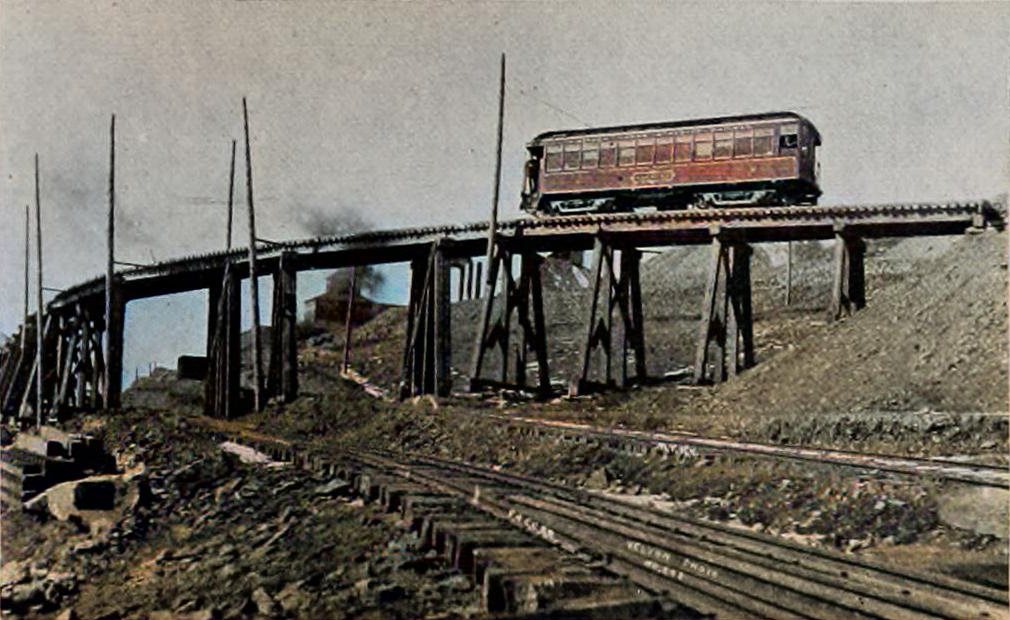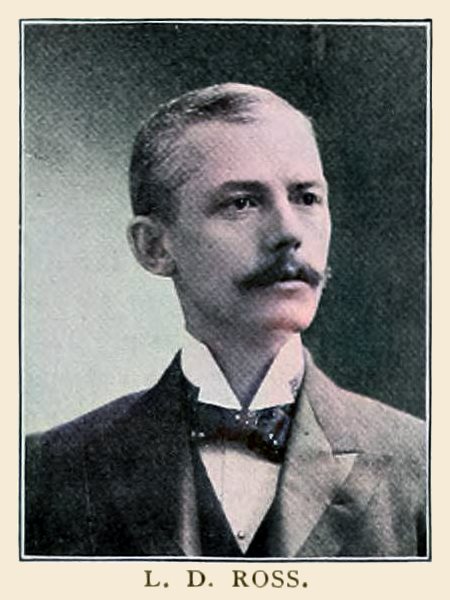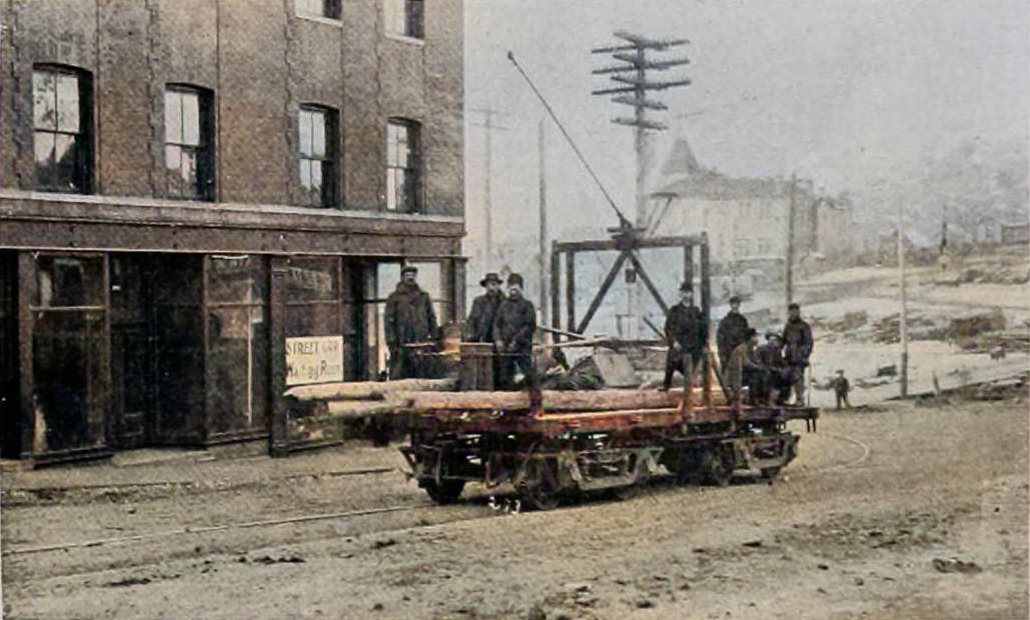-> Can be found at the Internet Archive Site. Link to first page of article.
(pages 707-710)
[I procured the coloring of the images, article used grayish]
————————————————————————————————————
By the introduction of the three-phase system of electrical transmission the development of the transformer of large capacity and the rotary converter, a great and lasting element of change has been brought into electric railway practice with ultimate consequences which escape the predictions of even the most sanguine. High tension three-phase alternating current reduced in transformers and changed in converters to low tension direct current for use with ordinary electric street cars was first employed at Portland, Ore. At Lowell, Mass., this method was first adopted for the operation of long interurban electric railway service, with gratifying success, and since then, in almost all cases involving a transmission of power, beyond the economical limits of the directly generated direct current, three-phase systems similar to those at Portland and Lowell are employed. For the operation of the great underground electric road in London and the no less great system of the Metropolitan Street Railway Company, of New York, involving intricate transmission and distribution, the three-phase system will also be used.
From Cripple Creek to Victor, in Colorado, runs the recently installed road of the Cripple Creek District Railway, First Division, a line some six miles long—the first installment of an interurban network which will eventually connect many of the busy mining towns of Colorado, As the road will ultimately cover long distances, the three-phase system with current generated at high pressure, transmitted, reduced and converted has been adopted as most suitable to the eventual demands.
The source of the power is the flow from the different water sheds from Pike's Peak. The site of the power house is located a few hundred feet above Lake Moraine, in close proximity to the rack road leading from Manitou to Pike's Peak. The water is brought through a riveted steel pipe line about 2,700 ft. long to a 4-ft. Pelton water wheel, running at 500 r. p. m. under a head of 700 ft.
To the wheel is directly connected a 225-k. w., three-phase alternator, wound to deliver current directly to the line at a pressure of 6,300 volts and a periodicity of 25 cycles. The exciting current is obtained from a multipolar current generator, directly connected to an 18-in. water motor running at 1,400 r. p. m.
Previous to the installation of the three-phase generating plant, continuous railway current was furnished to the trolley line at 550 volts from the Cripple Creek lighting station, where the railway company installed a 225-k. w. multipolar direct current generator driven by an Armington & Sims compound engine. This steam plant will be held as a reserve upon which to call in case of emergency.
The generating station switchboard is built of two blue Vermont marble panels, one for the generator and one for the exciter, equipped with the usual indicating, measuring and controlling instruments. The high potential switches are of the extremely quick-break type and are unprovided with handles, the opening of the blade being effected by means of a long stick with a hook at the end, which hook is inserted in an eye in the free end of the switch. The switch blades are separated from each other by marble barriers to eliminate all chance of arcing between the blades. In order to bring the blades away from the board both hinge and clips are mounted on corrugated rubber cones about 3½ in. high. Similar pyramids intervene between the back of the board and the high potential connections.
Two sets of lightning arresters are used, one set being placed in the generating station itself and another in a lightning arrester house a few feet distant from the station. As the station and line are situated in a locality some 10,000 ft. above sea level, where electric storms are frequent, the necessity for reliable lightning arresters is forcibly brought home to the station manager at oft recurring intervals.
From the power house the circuits run over a pole line as far as the Horse Shoe Pass, the wires being strung on Locke triple petticoated high potential insulators. Along the tops of the poles runs a bare iron wire grounded every few poles, as an additional protection against lightning. The total length of the transmission line is about 9 miles.
The transformer and converter substation is located at Horse Shoe Pass, at the Station Midway, half-way between Victor and Cripple Creek and about midway between the terminals of the first division of the railroad. The reducing transformer equipment consists of three 75-k. w. transformers, cooled by a current of air forced up through the core and windings. In these the pressure is reduced to 350 volts, and at this pressure the three-phase current passes to one 200-k. w. rotary converter running at 750 r. p. m., and feeds to the trolley wire from the commutator side, direct railway current at a pressure of 550 volts. The switchboard in the sub-station consists of a single panel fully equipped with the necessary apparatus.
The line is 6.25 miles long, single track with two turn-outs and three spurs. It runs from Cripple Creek to Victor, with terminal facilities, car barns and offices being at the former town. The illustrations show clearly the nature of the country through which it passes. It may be said to be made up entirely of grades and curves, and, indeed, according to an engineer who recently inspected it, "There is not enough straight track on the whole road to make a decent crowbar!"
The average grade between Cripple Creek and Midway is 6.09 per cent, the maximum rising to 7½ per cent. Between Midway station and Victor the average grade is 4.68 per cent. The track is laid with 60-lb. T-rail on ties closely laid and well ballasted. It is bonded with terminal bonds of two No. 0000 copper wires. The track and roadbed have apparently been laid down with the sole end in view of permanency of installation and solidity of construction.
The rolling stock consists of three 40-ft. closed vestibuled double truck cars, manufactured by the Barney & Smith Car Company for the passenger service and one 33-ft. 6-in. double truck baggage and freight car. Each passenger car is equipped with two 50-h. p. motors with two series-parallel controllers, and the baggage car with four 35-h. p. motors and two controllers. All the cars are provided with Christensen air brakes and air whistles.
The road has been in operation since January 2, 1898, on a strictly railroad basis, with fixed time schedule. Since traffic was inaugurated, no trip has been lost nor have any difficulties been encountered not already provided for before actual operation was begun. The successful operation of this road goes far to prove that, even under the very severe conditions which obtain in this case, it is possible to maintain a perfect steam railroad schedule on a single track electric interurban road.
The road has six stations—the terminals at Cripple Creek and Victor, and Anchoria, Midway, Windy Point and Dyer stations in the order named from Cripple Creek. The round trip is at present made in one hour and 29 minutes at an average speed of about 10 miles an hour, but this speed will shortly be increased to make a round trip between Cripple Creek and Victor in one hour.
The road was promoted, constructed and is under the general management of L. D. Ross, vice-president of the company. H. I. Reid, formerly of Chicago, and later of Omaha, is chief engineer and electrician. Only passenger traffic has been handled up to the present time, but the road has been built and equipment has been ordered to haul ore and other freight in the district. The road is building and will have in service within another 60 days four more passenger cars to take care of the passenger traffic alone. The road is set down as a money earner.
Surveys are now being conducted with a view to extending the line from the Horse Shoe Pass as far as Colorado Springs—a distance of about 32 miles—passing Lake Moraine and Bear Creek Canon.
The work of construction on the extension it is expected will shortly be begun. The current will be furnished on the three-phase system, generated by water-wheel-driven dynamos at high voltage, transformed down and converted at sub-stations in the manner identical with the installation which forms the subject of this article.
L. D. Ross, vice-president of the Cripple Creek District Railway Company, and who has promoted and constructed and had the general management of the road, began his railroad work 22 years ago as telegraph operator and had 10 years' experience in the different departments of steam railway companies, including the construction of 165 miles of new road.
Ten years ago Mr. Ross became interested in electric railways, and has been identified with several successful companies. He came to Colorado in 1896, from Seattle, Wash., and upon his arrival in the Cripple Creek mining district saw the need of an electric railway to furnish cheap transportation to carry the miners to and from the mines, as well as to lessen the cost of hauling all kinds of freight, especially ore and coal.
Having thoroughly investigated the possible earnings of such a railway, Mr. Ross secured his franchises from the well populated towns of Cripple Creek, Victor and Gillett, and by proper survey located his electric line through the district, connecting the towns and principal shipping mines. He then went to London and associated with him in the enterprise English capital.
On his return construction of the line between Cripple Creek and Victor was begun in June, 1897, and was completed and put in operation January 2, 1898. In the beginning of the construction of the electric line, he found the steam railways were much opposed to having their territory invaded by such cheap transportation, and as they controlled and made the price of coal in the district, he realized necessity for having cheaper power.
After making a thorough examination of all the water sources near the Cripple Creek district for the purpose of generating electric power by water power transmission plants, he found a large water power available in the Colorado Springs water system, and offered to the city of Colorado Springs for the use of this water to generate power for electric railway purposes, to extend the line from the Cripple Creek district to the city of Colorado Springs, a distance of 32 miles.
He secured this franchise and completed his surveys, locating the line between the mining district and Colorado Springs, and while doing so, installed his first water power station at the head of Lake Moraine, transmitting power nine miles to the electric railway in the Cripple Creek district, completing same on July 2, 1898, and since that time has been operating the electric railway with this power. He expects shortly to begin construction of the main line to Colorado Springs, and hopes to have same completed and in operation within eight months.









